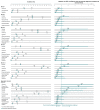Long-term tolerability of once-monthly injectable paliperidone palmitate in subjects with recently diagnosed schizophrenia
- PMID: 22956873
- PMCID: PMC3431970
- DOI: 10.2147/NDT.S32581
Long-term tolerability of once-monthly injectable paliperidone palmitate in subjects with recently diagnosed schizophrenia
Abstract
Background: A post hoc analysis from a multiphase trial with open-label transition and maintenance phases, a double-blind relapse prevention phase, and an optional open-label extension examined the long-term tolerability with continuous once-monthly injectable paliperidone palmitate 39, 78, 117, or 156 mg (25, 50, 75, or 100 mg equivalents [mg eq] of paliperidone) in subjects with recently diagnosed (≤5 years; n = 216) versus chronic illness (>5 years; n = 429) schizophrenia.
Methods: Adverse events reported at a ≥2% margin between subgroups were identified. Relative risks (in the recently diagnosed compared with the chronically ill) and 95% confidence intervals (CI) were determined, and CI not including 1 were considered potentially significant.
Results: In both subgroups, the mean monthly dose was 109 mg (69.9 mg eq). Continuous mean exposures were 333.9 ± 271.9 and 308.7 ± 278.3 days in the recently diagnosed and chronic illness subgroups, respectively. Using the criteria outlined in the methods, nasopharyngitis was a potentially significant event reported in more chronically ill than recently diagnosed subjects at months 6, 9, 12, and endpoint (7.2% versus 2.8%; relative risk 0.384; 95% CI 0.163-0.907). Influenza (2.8% versus 0.7%; relative risk 3.9; 95% CI 1.003-15.730) and amenorrhea (3.2% versus 0.9%; relative risk 3.476; 95% CI 1.029-11.744) at endpoint were potentially significant events in more recently diagnosed than chronically ill subjects. Mean weight changes, sedation/somnolence, any extrapyramidal symptom-related or glucose-related events were generally similar between the groups. The mean prolactin level increased in both sexes in both subgroups (changes from baseline of +41.8 ng/mL and +26.5 ng/mL in recently diagnosed and chronic illness females and +12.3 ng/mL and +15.1 ng/mL in recently diagnosed and chronic illness males, respectively), and were higher in females with recently diagnosed illness than in females who were chronically ill (P = 0.0002 at endpoint). Prolactin-related events were reported by 7.9% of recently diagnosed subjects with schizophrenia and 3.5% of those who were chronically ill.
Conclusion: The long-term tolerability of paliperidone palmitate was generally similar in recently diagnosed schizophrenia subjects and those with more chronic illness, with the exception of some prolactin-related measures.
Keywords: early illness; long-acting antipsychotic; paliperidone palmitate; recently diagnosed; schizophrenia.
Figures



Similar articles
-
Profile of paliperidone palmitate once-monthly long-acting injectable in the management of schizophrenia: long-term safety, efficacy, and patient acceptability - a review.Patient Prefer Adherence. 2015 May 25;9:695-706. doi: 10.2147/PPA.S63948. eCollection 2015. Patient Prefer Adherence. 2015. PMID: 26082620 Free PMC article. Review.
-
Tolerability of initiation doses of once-monthly paliperidone palmitate in patients with recently diagnosed schizophrenia in an acute treatment trial.Ther Adv Psychopharmacol. 2011 Aug;1(4):111-24. doi: 10.1177/2045125311413006. Ther Adv Psychopharmacol. 2011. PMID: 23983935 Free PMC article.
-
Onset of efficacy and tolerability following the initiation dosing of long-acting paliperidone palmitate: post-hoc analyses of a randomized, double-blind clinical trial.BMC Psychiatry. 2011 May 10;11:79. doi: 10.1186/1471-244X-11-79. BMC Psychiatry. 2011. PMID: 21569242 Free PMC article. Clinical Trial.
-
A 52-week open-label study of the safety and tolerability of paliperidone palmitate in patients with schizophrenia.J Psychopharmacol. 2011 May;25(5):685-97. doi: 10.1177/0269881110372817. Epub 2010 Jul 8. J Psychopharmacol. 2011. PMID: 20615933 Clinical Trial.
-
Efficacy and safety profile of paliperidone palmitate injections in the management of patients with schizophrenia: an evidence-based review.Neuropsychiatr Dis Treat. 2018 Jan 5;14:205-223. doi: 10.2147/NDT.S139633. eCollection 2018. Neuropsychiatr Dis Treat. 2018. PMID: 29379293 Free PMC article. Review.
Cited by
-
Patient-psychiatrist discordance and drivers of prescribing long-acting injectable antipsychotics for schizophrenia management in the real-world: a point-in-time survey.BMC Psychiatry. 2022 Mar 17;22(1):187. doi: 10.1186/s12888-022-03846-x. BMC Psychiatry. 2022. PMID: 35300629 Free PMC article.
-
Paliperidone Palmitate Once-Monthly Treatment in Recent Onset and Chronic Illness Patients With Schizoaffective Disorder.J Nerv Ment Dis. 2017 Apr;205(4):324-328. doi: 10.1097/NMD.0000000000000646. J Nerv Ment Dis. 2017. PMID: 28005578 Free PMC article. Clinical Trial.
-
Aripiprazole once-monthly 400 mg for long-term maintenance treatment of schizophrenia: a 52-week open-label study.NPJ Schizophr. 2015 Nov 4;1:15039. doi: 10.1038/npjschz.2015.39. eCollection 2015. NPJ Schizophr. 2015. PMID: 27336044 Free PMC article.
-
Profile of paliperidone palmitate once-monthly long-acting injectable in the management of schizophrenia: long-term safety, efficacy, and patient acceptability - a review.Patient Prefer Adherence. 2015 May 25;9:695-706. doi: 10.2147/PPA.S63948. eCollection 2015. Patient Prefer Adherence. 2015. PMID: 26082620 Free PMC article. Review.
-
Long-acting injectable antipsychotics for early psychosis: A comprehensive systematic review.PLoS One. 2022 Apr 29;17(4):e0267808. doi: 10.1371/journal.pone.0267808. eCollection 2022. PLoS One. 2022. PMID: 35486616 Free PMC article.
References
-
- Marshall M, Rathbone J. Early intervention for psychosis. Cochrane Database Syst Rev. 2006;4:CD004718. - PubMed
-
- Kevashan MS, Amirsadri A. Early intervention in schizophrenia: current and future perspectives. Curr Psychiatry Rep. 2007;9:325–328. - PubMed
-
- Lieberman JA. Is schizophrenia a neurodegenerative disorder? A clinical and neurobiological perspective. Biol Psychiatry. 1999;46:729–739. - PubMed
-
- Lieberman JA, Perkins D, Belger A, et al. The early stages of schizophrenia: speculations on pathogenesis, pathophysiology, and therapeutic approaches. Biol Psychiatry. 2001;50:884–897. - PubMed
LinkOut - more resources
Full Text Sources

